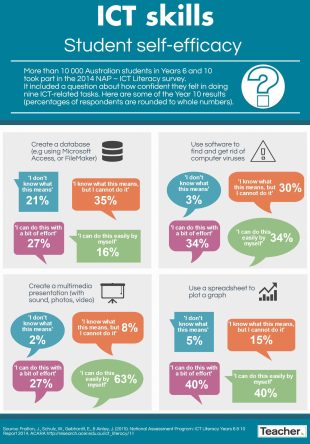Females are consistently showing a significantly higher level of ICT literacy than their male counterparts, new results from a triennial assessment show.
Results from the 2017 test cycle of the NAP-ICT (National Assessment Program – Information and Communication Technology) Literacy Sample Assessment were released at the end of last term, and also show that the difference in performance between Indigenous and non-Indigenous students remains considerable.
The assessment is facilitated by ACARA (Australian Curriculum, Assessment and Reporting Authority) and involves students in Year 6 and Year 10, from a sample of schools in Australia.
Participants are assessed on their ICT literacy abilities – that is, their skills in accessing and managing information, creating information products, and using ICT responsibly by considering social, legal and ethical questions, among other real-world ICT-related skills.
The assessment is now in its fifth cycle. The 2017 online test was delivered to 5439 Year 6 students in 327 schools and 4885 Year 10 students in 313 schools. The results show stark differences across various demographics and, interestingly, little improvement since the test's fourth cycle in 2014. Variances across demographics can be seen through the gaps in both scale scores and the percentage of students who attained what is termed the ‘proficient' standard.
Results at a glance
Nationally, the average scale score of Year 6 students was 410. For Year 10, it was 523. This means that 53 per cent of students in Year 6, and 54 per cent of students in Year 10, reached the proficient standard in the 2017 test cycle.
These average scale score results show a decline in performance since 2011 of 25 and 36 score points for Year 6 and Year 10, respectively. When comparing 2017 results to 2014, however, the results are stable – Year 10 students fared three points higher in 2017, and Year 6 students three points lower.
‘… The findings in this report suggest that there is an opportunity in Australia for student ICT literacy to improve,' chair of the ACARA Board, Belinda Robinson, said.
Gender differences
The gender difference across all measurements was clear. Female students achieved results 14 score points higher than male students in Year 6, and Year 10 results showed a 19 point margin.
Looking at the proficient standard, a higher number of female students (56 per cent) in Year 6 reached the standard than male students (51 per cent). A similar difference was evident in the results for Year 10 students, with 58 per cent of female students achieving proficiency compared to 51 per cent of males.
Student background differences
The results from the 2017 NAP-ICT Literacy assessments showed a clear difference in scale scores for students living in different geographical locations. For metropolitan students in Year 6, 58 per cent achieved the proficient standard, compared to 43 per cent in regional areas and 35 per cent in remote areas. In Year 10, 57 per cent of students in metropolitan areas achieved proficiency, compared to 48 per cent in regional areas and 31 per cent in remote areas.
For Indigenous students, the national percentage of students to reach the proficient standard in both Year 6 and Year 10 was 24 per cent, compared to 55 per cent of non-Indigenous students.
Students in Year 6 who speak a language other than English at home outperformed students who speak English at home by 13 scale points. And, for students in Year 10, those who were born in Australia attained results 21 score points higher than students born overseas.
Use of digital devices
Students also completed a survey about their IT use in school and during their own time outside of school. For the first time, this assessment cycle broadened the survey questions from only asking students about computer use, to questioning their use of any digital device.
Results showed that higher levels of digital device experience were associated with higher levels of ICT literacy, especially for Year 10 students. According to the report, 64 per cent of Year 6 students and 79 per cent of Year 10 students said they had at least five years' experience using digital devices.
Students also rated the importance of using digital devices – Year 10s gave this a higher rating than Year 6 students did, and males gave a higher rating than females.
For both Year 6 and 10, the data show students with lower ICT literacy achievement were more likely to report they used entertainment applications frequently while at school.
Stay tuned: Teacher will be exploring what these average scale scores might look like in the classroom, in terms of ICT tasks students at different levels are likely to be able to perform.
Thinking about your own school context, is there a noticeable disparity between genders in terms of proficiency in ICT literacy? What steps could you take to address this?
To find out more, you can download the full report on ACARA’s website (4.3MB).



